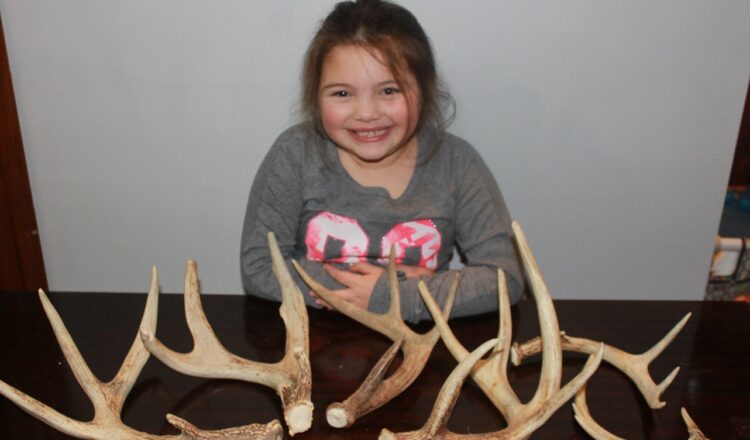Getting the family outdoors in late-winter can sometimes be a daunting task. If they aren’t into downhill skiing or ice skating it’s a hard to get kids gung ho about heading out into the cold. Or, if we’re amidst a thaw – or a warm winter like this — it’s tough to get them interested in traipsing through muddy fields and forests.
Sometimes they need a little extra encouragement.
Why not take them on a treasure hunt?
Get them looking for deer sheds every weekend during which there’s no – or a limited amount of – snow on the ground.
Whitetail deer aren’t like beasts that have horns that can last a lifetime. Deer antlers are shed after the end of each breeding season and slowly grow back through the spring and summer so they are ready for the next wave of mating rituals in the fall.
Over the past few weeks, bucks across the Allegany County have been dropping their antlers. This generally happens after their testosterone levels plummet following the secondary and tertiary ruts (breeding peaks) or when colder weather causes their diets to change and their bodies to adjust. While some older or less-healthy bucks may have shed in early-January, younger and stronger ones began shedding in mid-February.
Finding sheds is no easy task. Although your local farm or forest might have a decent number of deer, think of how many are actually male or how much area you have to cover to find the cast-off antler. It can sometimes be like finding a needle in a haystack. But, that’s what makes shed hunting so rewarding – every rack is treasure, whether it came off of a small 4-point or a monstrous 12-point.
You can maximize your chances by searching areas where deer travel through or congregate.
In the dead of winter you can see well-worn deer runs or paths in the woods or grasslands. Follow those and look in and beside them for sheds. Many times a deer will need a little help from a branch or a tree trunk to tear off the shed, so thickly-wooded and brushy areas are the best place to look.
But, don’t overlook open spaces. There are times when racks will just fall off without any help. So, if you routinely see a herd of deer eating out in a field before nightfall, give that area a search. Those deer spend a lot of time there – sometimes hours at a time — so that increases the chance that a rack could fall there. My family and I have found more racks in open fields than in woodlots in recent years.
Keep your eyes peeled while on the treasure hunt. One would think a stark white rack would stick out like a sore thumb in the leaf litter and mud. That’s not necessarily the case. Many antlers are more of a lighter brown hue that’s well-camouflaged on the forest floor or in corn stubble and others are brushed with mud depending on the buck’s feeding habits or how he tried to pop-off that rack.
Realize, too, that time is of the essence. You wouldn’t want to do a shed hunt when the forest floor is green and growing in May, and you definitely want to beat other animals to it. Racks don’t last long in the wild. Mice and squirrels will eat them to get calcium and other nutrients to sustain them through the lean winter and early-spring months.
What do you do with racks once you find them?
Kids are collectors. They’ll hold onto the rack and set it aside in their bedroom or play area, or maybe they’ll take it to show-and-tell at school, which will lead into larger discussions about nature.
Adults are collectors, too. An accumulation of racks large and small makes for a great conversation starter at home, as visitors reflect on their encounters with big bucks, whether as a naturalist, hunter, or even a motorist. These racks can also dress up the home, too, filling out mantles or becoming intricate crafts – I’m sure you’ve seen photos of chandeliers and lamps made of antlers.
But, these racks are more than just the trophy. As with other forms of hunting, it’s about the experience, too. Enjoy the time spent outdoors — deep in the woods or slipping and sliding across a muddy field – with your children. You’ll always remember that respite from cabin fever, especially if your smiling child is lucky enough to find what you were looking for.







